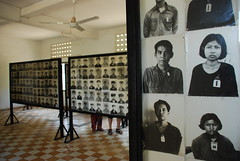i postponed the visit to Tuol Sleng as long as i could. Didn’t want to face reality and find out what happened. Strangely i felt conscious of the whole genocide thing as soon as we landed in Phnom Penh .. as though the soul of this country was still deeply wounded and grieving.
 At the museum, i ended up stumbling on a small room, filled with dust and storage. i don’t think this room was meant to be open. There was a big box of skulls and bones, not organised for display, just sitting; this was more disturbing than viewing the skulls on proper display.
At the museum, i ended up stumbling on a small room, filled with dust and storage. i don’t think this room was meant to be open. There was a big box of skulls and bones, not organised for display, just sitting; this was more disturbing than viewing the skulls on proper display.
Many skulls in another room had been given proper display cabinets, with airholes so that the victim’s souls could enter and connect. This was a compromise between giving them proper burial, and allowing the world to see the evidence of what happened.
i took some photos in the not-display room, but felt like i shouldn’t .. so perhaps i won’t publish them here. i’ll put other people’s photos instead.
 So the genocide researchers have found 389 burial sites .. most with 500-1500 people. There was one site with 150,000 people and the biggest site had 510,000 dead bodies. Tim and i tried to work out how big that would be.
So the genocide researchers have found 389 burial sites .. most with 500-1500 people. There was one site with 150,000 people and the biggest site had 510,000 dead bodies. Tim and i tried to work out how big that would be.
Really Big.
At the start of the revolution, people were marched out of the cities into the country to become honourable peasants. If the inner bourgeoisie couldn’t be marched out of them, they were killed. Doctors, teachers .. anyone educated was killed.
Ironic, because Pot and some of his henchmen were teachers who’d had a very elitist education in Paris.
.
These days in Cambodge, they don’t kill people so much, just sell off land to developers and march the peasants off to another part of the city, possibly with a skerrick of compensation. This article at the bbc gives detail, via Kylie in Phnom Penh.
.
 photo credit: blake_lennon
photo credit: blake_lennon
 photo credit: tkelly7029
photo credit: tkelly7029
Plus: